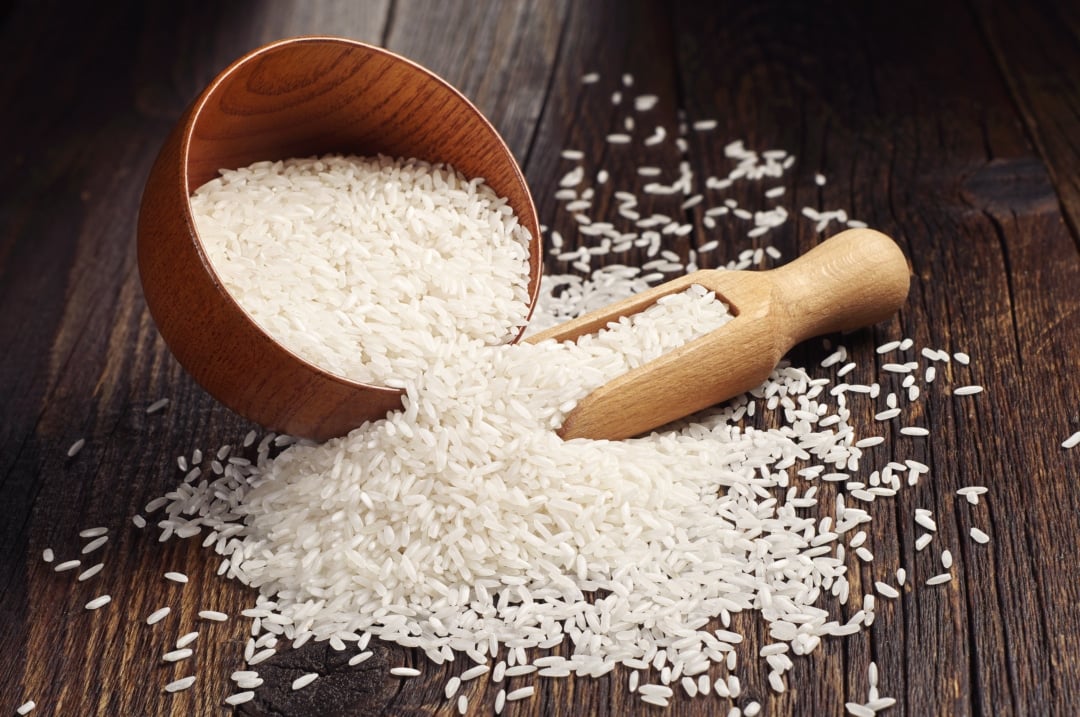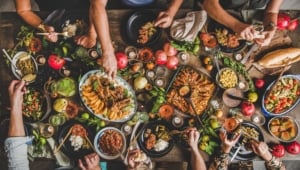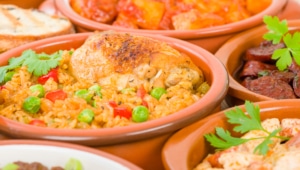Vietnamese Food: 6 Popular Dishes + 8 Secret Recipe Tips
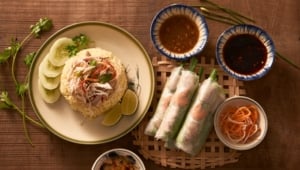
When people hear of Vietnamese food, they immediately think of pho and banh mi. Yet, the country has so much more to offer. In this article, we’ll take you on a journey through some of the most delicious Vietnamese dishes.
Vietnam has a long and exciting history, filled with spices and delectable dishes. From bun cha to bun bo hue, the options are endless.
In this article, we’ll walk you through some of the most popular Vietnamese dishes. We’ll also cover a few tips that can help you try this cuisine at home.
Traditional Vietnamese Cuisine – More Than Pho and Banh Mi

Traditional Vietnamese Cuisine – More Than Pho and Banh Mi
Many people around the world are familiar with pho. It’s a Vietnamese soup dish that consists of rice, broth, noodles, herbs, and protein. Plus, you can add a whole host of other toppings to customize the meal.
These include pickled mustard greens, sprouts, mint, basil, cilantro, and pickled pineapples. This makes for a hearty dish that can keep you full for hours. On top of that, the meal contains all sorts of minerals and vitamins that you need to stay energized for the day.
Moving on, banh mi is another well-liked Vietnamese invention. It’s a short baguette with a thin, crispy crust that we split sideways and fill with several ingredients.
For instance, you may enjoy building your sandwiches with cured meats, sliced cucumber, pickled carrots, and daikon. Plus, you can include crisp cilantro, fresh chilis, or jalapeno for an extra kick to the meal.
For these reasons, foodies from all over the globe fell head over heels for these Vietnamese dishes. However, because of how famous pho and banh mi are, people tend to forget that this Southeast Asian cuisine has plenty more to offer.
There are hundreds of other Vietnamese dishes and sweet treats that deserve a moment in the spotlight. From simple, heartwarming meals to extravagant courses chock full of exceptional spices and herbs.
These dishes are a mix of bold flavors and interesting texture combinations that blend salty and sweet elements perfectly to create a unique palate. When people hear this, they assume that Vietnamese cuisine is complex and the recipes will take hours to follow.
Yet, that’s not the case. Most meals from this Southeast Asian country use simple ingredients and are easy to prepare in a flash. For that reason, these dishes have become so popular around the world.
Most Popular Street Food in Vietnam

Most Popular Street Food in Vietnam
One of the best ways to experience Vietnamese culture is through its street food. The meals have a unique charm and an exceptionally rich cultural background. While roaming the streets of Vietnam, you’ll come across countless vendors that offer all sorts of delectable treats.
These dishes are typically hearty with simple flavor profiles that’ll keep you coming back for seconds. So, without further ado, let’s take a look at some of the street food that Vietnam has to offer.
Cao Lau: Spiced Pork With Noodles
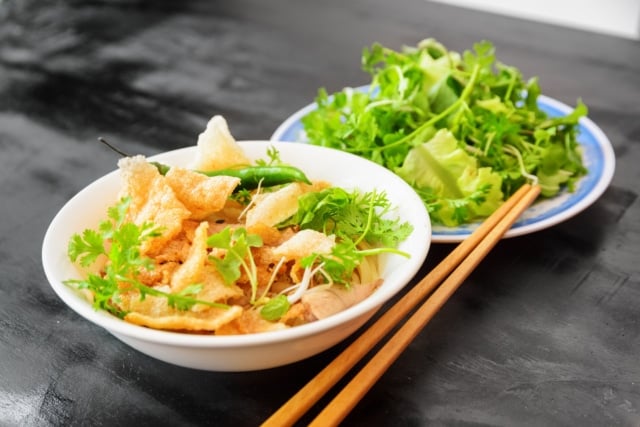
Cao Lau: Spiced Pork With Noodles
If you’re a fan of Asian cuisine, chances are you’ve heard of cao lau. It’s a noodle dish that’s topped off with a wide variety of ingredients. A few of the most common additions include rice, meat, greens, bean sprouts, and herbs.
This makes for a dish that incorporates all the main components of a well-balanced diet. Because of that, many Vietnamese locals like to start their days with cao lau. So, you should be able to find this dish on every street corner of the country.
Bun Cha: Vietnamese Meatballs
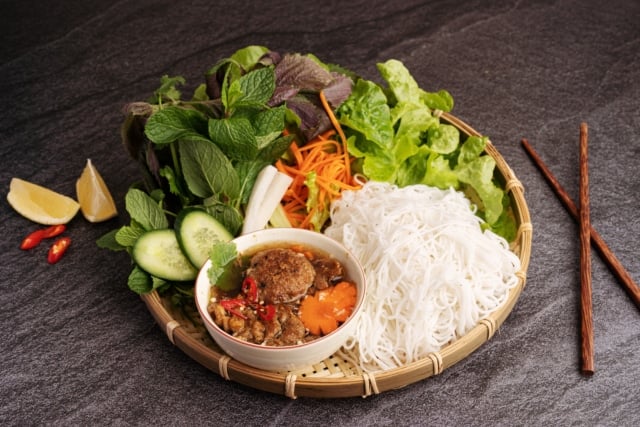
Bun Cha: Vietnamese Meatballs
No cuisine is complete without a version of the classic meatball. Well, Vietnam’s answer to this is bun cha. These are similar to the meatballs we all know and love, but with a few significant twists. For starters, the main ingredient Vietnamese people use for this dish is seasoned pork.
After marinating the protein overnight, locals throw it over a charcoal fire to cook the meat and infuse it with a smokey flavor. Plus, as soon as they’re on the grill, people flatten them out using a spatula to create a patty.
This more closely resembles burgers than meatballs. On top of that, the meal comes with a side of grilled fatty pork belly that adds an extra layer of savory goodness. In addition, locals serve bun cha with rice or noodles.
Finally, we can’t forget about the dipping sauces. Bun cha often comes with fish sauce or a heavy broth that adds a lot of moisture and a zesty kick to the meatballs.
Banh Xeo: Crispy Vietnamese Pancakes
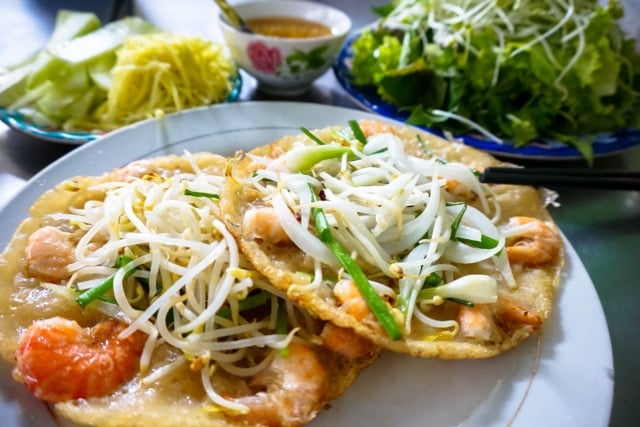
Banh Xeo: Crispy Vietnamese Pancakes
Banh xeo is one of the most famous Vietnamese street food options. It has a long, colorful history with a distinct flavor profile. Its name loosely translates to sizzling pancakes, and the dish doesn’t disappoint.
Right off the bat, the main ingredient of the pancakes is rice flour. Then, we season the batter with turmeric and add water to combine the components together. This makes for a peppery, earthy dish.
Plus, since there isn’t much gluten in rice, you get a light, airy batter. So, as soon as you throw the pancakes on a skillet, the edges will crisp up while the center remains soft and chewy.
While this already sounds like a delicious treat, it doesn’t end there. Locals also like to stuff their banh xeo with a whole host of toppers to round out the meal. These include shrimp, pork belly, and bean sprouts.
Goi Cuon or Nem Ran: Vietnamese Spring Rolls
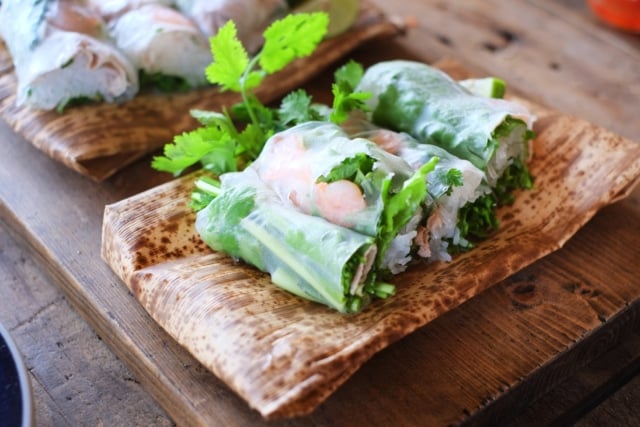
Goi Cuon or Nem Ran: Vietnamese Spring Rolls
Most of us are familiar with spring rolls. These are appetizers commonly found in most Southeast Asian cuisines. These starters are delectable and easy to eat. This makes them the ideal snack for any busy individual on the go.
Luckily, Vietnam has its own version of the dish, goi cuon. These appetizers usually consist of pork, prawn, vegetables, bun, and other ingredients. Then, we wrap these components in banh trang, which is Vietnamese rice paper.
The best part about this dish is that it’s completely customizable. Depending on the street vendor you visit, you can experience unique flavor combinations that make your mouth water.
Moving on, in its raw form, banh trang is soft and chewy. Yet, if you’re looking for a crispy treat, you can try the fried version of the dish called nem ran.
Lastly, you can’t eat goi cuon or nem ran without a selection of dipping sauces. Some of them are more traditional, like soy sauce and fish sauce. However, you can also dip your spring rolls in ketchup or mayo.
Xoi: Sweet Sticky Rice

Xoi: Sweet Sticky Rice
While most street food in Vietnam is savory, the region still has plenty of sweet treats to offer. A great example of that is xoi. This is a dessert made of sticky rice and flavored with many ingredients.
One of the popular versions of the dish is glutinous rice steamed with coconut milk and sugar. It makes for a subtly sweet treat that can round out any meal. Besides that, locals like to top the dessert with more coconut, roasted peanuts or sesame seeds, and powdered sugar.
Moving on, you can find a few savory versions of xoi. Instead of coconut milk, Vietnamese people prepare this dish using broth and other spices and herbs.
Vietnamese Food in the World
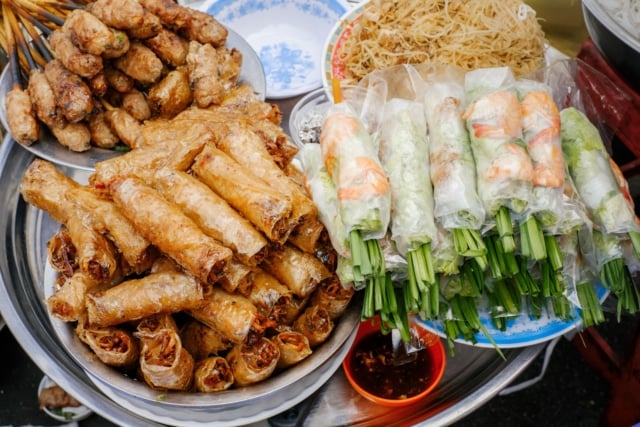
Vietnamese Food in the World
Vietnamese cuisine has been around for hundreds of years and is constantly evolving. Yet, over the past few years, the cooking style has exploded on the food scene.
Thanks to the rise in the popularity of the Vietnamese media, more people are being introduced to the cuisine on a daily basis.
Because of that, the cooking style increased its presence worldwide. On top of that, Vietnamese cooking incorporates elements of Chinese cuisine, Khmer cuisine, Thai cuisine, and French cuisine, which are some of the most well-liked cooking styles.
Today, Vietnamese cuisine is the 20th most popular across the globe, and it’s showing no signs of slowing down.
How Healthy Is Vietnamese Food
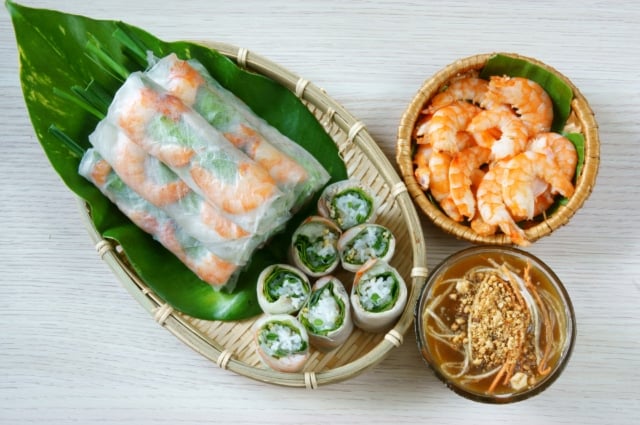
How Healthy Is Vietnamese Food
If you browse the massive catalog of dishes in Vietnamese cuisine, you’ll notice that most options are relatively healthy.
That’s because the meals revolve around rice, vegetables, and fish. These components make for a well-balanced diet with all the vitamins and minerals you need to stay healthy.
On top of that, this cooking style doesn’t rely on a lot of oil. So, Vietnamese cuisine tends to be healthier than traditional American cooking.
Moving on, Vietnamese people don’t consume much dairy. This means their dishes are typically low in salt, saturated fats, and sugars. For that reason, if you’re trying to lose a few extra pounds, this cuisine can help you get started.
Besides that, there are a few regions in Vietnam where the locals like spicy food. While opinions differ on fiery meals, most people can agree that, in small portions, it’s good for you. That’s thanks to capsaicin, the chemical that gives peppers their fiery kick.
This component can help regulate blood pressure and blood sugar levels and improve blood circulation. So, capsaicin can help you lose weight. To top it all off, most Vietnamese dishes rely on healthy cooking methods like steaming and stir-frying.
However, not all aspects of Vietnamese cuisine are healthy. There are a few indulgent dishes that come with high salt and fat levels. This can be a significant problem for people dealing with chronic conditions like high blood pressure.
Unfortunately, that means it can be a little tricky to decide if a Vietnamese dish is good for you. So, to make your life simpler, here are a few healthy options:
- Gao Lut: This is Vietnamese brown rice. It contains more nutrients and dietary fiber than regular sticky rice, which makes it the healthier alternative.
- Canh Chua: This is a Vietnamese sour soup made with fish, pineapple, tomatoes, and bean sprouts.
- Chao Ga: This is rice porridge or congee flavored with chicken soup and topped with vegetables and herbs.
- Rau Muong: The main ingredient of this dish is water spinach, which we stir-fry with garlic and other aromatics.
- Fruit: Vietnam boasts a wide variety of seasonal fruits that are all good for you. These include durian, dragon fruit, and sapodilla.
Famous and Popular Vietnamese Dishes You Have to Try
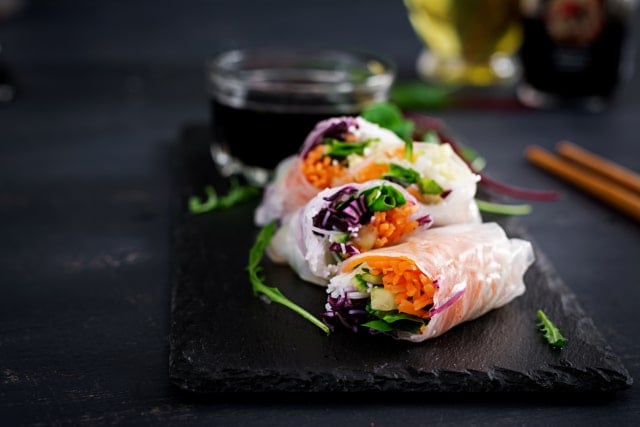
Famous and Popular Vietnamese Dishes You Have to Try
Most people think that cooking is just about throwing a few ingredients in a pot and mixing until all the components are ready to eat. However, when it comes to Vietnamese cuisine, food is a lot more than that. It’s a symphony of flavors that tells the story of the rich and vibrant culture of the country.
The dishes are a combination of exotic flavors, unique herbs and spices, and incredible textures. Because of that, they perfectly capture the essence of what life is like in Vietnam. From hearty meals that pack a powerful flavor punch to sweet treats, there’s an option for everyone.
Now that we’ve whet your appetite, let’s dive into six Vietnamese dishes that’ll leave your palate singing.
Bun Bo Nam Bo
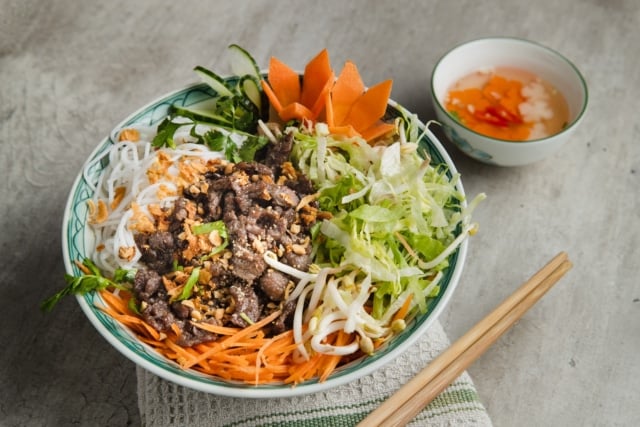
Bun Bo Nam Bo
Nun bo nam bo is a classic Vietnamese dish that has captivated the taste buds of locals and tourists alike. It’s a seamless blend of unique textures and aromas that represent the essence of the region. Not only that, but the meal is exceptionally healthy to boot.
For starters, the star ingredient of bun bo nam bo is thin slices of beef marinated in a combination of soy sauce, fish sauce, garlic, and lemongrass. You can also add a wide variety of spices and herbs to customize the flavor profile.
After a few hours of marinating, we throw the beef slices on a hot skillet to stir-fry them with an array of vibrant vegetables like sprouts and lettuce. This gives us a meal with a zesty aftertaste and a subtle crunch.
Ga Nuong

Ga Nuong
If you’re a fan of grilled chicken, you may want to try this Vietnamese spin on the popular dish. This meal captures the rich culinary history of Vietnam and is incredibly easy to prepare.
All you have to do is marinate your chicken in lemongrass, garlic, ginger, and fish sauce overnight. That tenderizes the protein and infuses it with tons of flavor. After that, heat up your grill to a high temperature and add the chicken pieces.
This will cook the protein and caramelize the sugar in the marinade. For that reason, you’ll end up with a nice tender meal that has a smokey flavor profile.
On top of that, the open flames will lead to a fair bit of charring. While most people avoid scorching their chicken, that may be a big mistake. That’s because the smoky charred areas perfectly complement the tangy profile of the marinade.
Pho
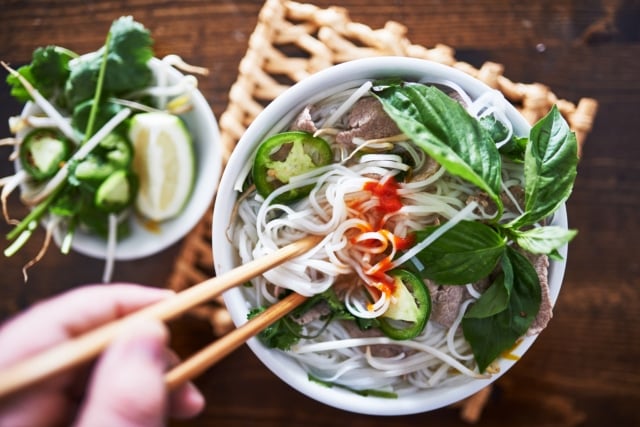
Pho
We can’t talk about Vietnamese cuisine without mentioning pho. This traditional noodle soup dish is a masterpiece that can soften the hearts of even the harshest food critics. It’s the definition of healthy, nutritious comfort food.
To help you understand how pho came about, we have to take a look at its history. We can trace some of the earliest versions of the meal back to the start of the 20th century. At the time, food was scarce, and people didn’t have access to a wide range of ingredients.
Yet, workers and laborers needed a hearty meal that could keep them full for hours. Because of that, people began combining any food they had lying around in their pantries.
They added noodles, vegetables, and protein. Plus, to bring all the flavors together, they boiled all of these ingredients in a broth. That’s how pho came about. Since its introduction, the dish evolved into a complex meal with various regional variations.
Not only is this treat easy to make, but it’s also exceptionally affordable. So, it’s no surprise that pho is the national dish of Vietnam.
Banh Khot

Banh Khot
We talked about banh xeo (crispy pancakes) and how delicious they can be. Yet, eating the meal can prove to be a messy process. Unless you’re using a knife and a fork, it can be tricky to ensure that the filling stays where it should.
Thankfully, Vietnam has a solution to this issue: banh khot. These are mini pancakes that have a similar flavor profile to banh xeo.
To make the batter, locals combine rice flour, coconut milk, turmeric powder, and water. Then, they pour this mixture into molds that create the signature mini-cup shape. After that, all that’s left is to add toppers like shrimp or fried pork belly and bake the pancakes until golden brown.
Plus, you can customize the filling to include any of your favorite ingredients. For example, locals like to add mint for an extra zesty kick. That makes for a light meal you can enjoy while on the go.
Com Tam

Com Tam
If you’re looking for a simple meal that packs a powerful flavor punch, com tam may be the answer. The name roughly translates to broken rice. This refers to the main component of the dish.
To make com tam, you mill rice until you’re left with a grainy powder. Once that’s done, the next step is to cook the ingredient in boiling water. While the flavor is similar to regular rice, the texture is completely different.
Since the grains are smaller, com tam tends to be fluffier and slightly chewy. This makes the dish much simpler to digest. On top of that, the tiny grains are better at soaking up sauces and flavors. That’s why many people like to drizzle a little nuoc cham on top.
Bun Dau Mam Tom
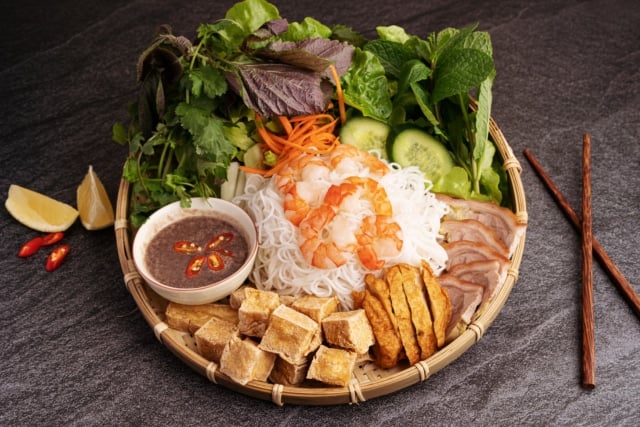
Bun Dau Mam Tom
The last dish on our list is bun dau mam tom. While the name may sound complicated, that shouldn’t stop you from enjoying the delicious flavor. It’s a subtle meal with many components and a tangy aftertaste.
For starters, bun dau mam tom consists of vermicelli noodles, countless vegetables, herbs, and fried tofu. Then, we top these ingredients with an aromatic shrimp paste sauce (mam tom).
At first, the shrimp sauce can be overpowering. So, if you’re intimidated by the component, try adding mint or cilantro to the recipe. These will soften the edges of the aromatic paste and bring out umami notes that’ll transform your meal.
As you can guess by the components, this dish is on the healthier side and doesn’t contain high fat levels. Because of that, it’s ideal for anyone trying to watch their figure.
Soups & Salads

Soups & Salads
In most cuisines around the world, soup plays the role of an appetizer. That’s why people usually serve this course at the beginning of a meal. However, that’s not the case with Vietnamese cuisine.
In this Southeast Asian cooking style, soup makes up a sizable portion of the main course. So, we can’t wrap up our journey through Vietnamese food without a stop at soup station. The region has countless stews with bold flavors to offer.
For starters, let’s take a look at bun bo hue. This dish consists of beef slices, pork knuckles, mushrooms, green onions, and green peppers. We simmer these ingredients over low heat for several hours to help the flavors marry.
Plus, the locals like to add a touch of chili flakes to give the meal a bit of a fiery kick. That’ll give you a savory broth that’s perfect for anyone with a cold.
Other than that, we have ga tan. This is herbal chicken soup with vegetables and sometimes tofu. While this may seem like a relatively tame choice, the flavor profile will leave your taste buds jumping in joy.
In addition, unlike traditional chicken soup, ga tan has a slightly sweet twist thanks to the combination of herbs and spices.
On top of that, the ingredients for this broth are readily available and affordable. So, you can make the dish at home without running out to a specialty Vietnamese grocery store.
Besides that, the Southeast Asian cooking style also offers plenty of salads for you to choose from. Some of the most popular options include goi ga, which is a chicken dish similar to a Caesar’s salad. Yet, this version comes with crunchy carrots and red onions for an extra bite.
Starters, Sandwiches, Sides
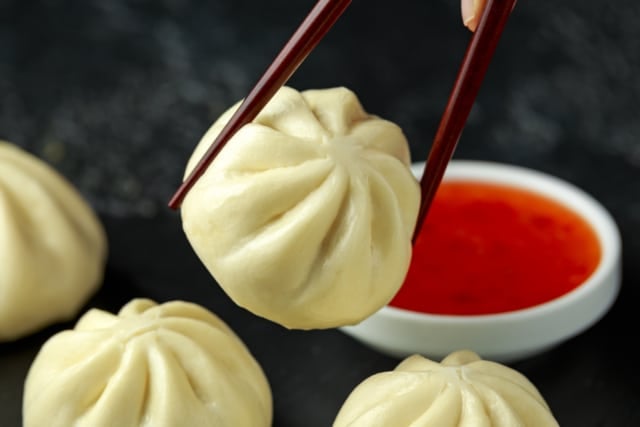
Starters, Sandwiches, Sides
One of the most crucial parts of any cooking style is the starters it has to offer. These dishes are the best way to whet your appetite and set the tone for the other courses.
Luckily, Vietnam has several delicious appetizers to offer, each with a special flair. They blend sweet, salty, and savory elements seamlessly to create a flavor party for your taste buds.
A great example of that is banh bao or steamed pork buns. These are small round pastries made using rice flour. Plus, they come with a wide variety of fillings. For instance, many locals like to add pork, onions, eggs, mushrooms, and other vegetables.
This makes for a chewy treat with a subtle flavor. You can eat banh bao as is, or dip the buns in fish sauce for a tangy twist.
Moving on, Vietnam also has many sandwiches to offer. We mentioned banh mi briefly, which is a baguette filled with cured meats and pickled vegetables. Plus, there are several variations of this dish.
For instance, some people like to add sardines and eggs on top. Yet, there are countless other options that are just as scrumptious. This includes meals like omelet bread. It’s a spin on French toast, but the final dish is savory. That makes it the perfect choice for a breakfast sandwich.
As for Vietnamese sides, we can’t forget to mention the vibrant green papaya salad. This dish consists of shredded unripe papaya, tomatoes, lettuce, and green bean sprouts.
Mains

Mains
When it comes to Vietnamese mains, there are tons of options that’ll leave you asking for seconds. From simple hearty dishes to extravagant meals with complex flavor profiles.
If you’re new to Vietnamese cuisine, it’s best to start your exploration of the cooking style with a subtle dish. A meal like bo la lot works perfectly for this purpose. It’s betel leaves wrapped around a mixture of beef, eggs, vegetables, and herbs and spices.
In their raw form, the leaves smell a tad spicy and bitter. Yet, as soon as you add a little heat to the equation, they’ll soften and lose their pungent aroma. Plus, they can soak up the flavors of the filling, making for a delectable treat.
Other than that, ca tim kho to is a main course dish with eggplants at the center. At first glance, it may seem like the vegetable choice isn’t all that exciting. However, with the right spices and flavorings, the eggplants will transform into delicate bites of heaven.
To make ca tim kho to, you mix eggplants with tomatoes, soy sauce, sugar, and in some recipes minced beef. Then, you slow-cook the ingredients in a clay pot to allow the flavors to get to know each other. While this meal may take a while to prepare, it’s definitely worth the wait.
Finally, bot chien is another popular main dish. It consists of fried rice flour dough chunks and slices of onions, shallots, and green papaya. Next, we top off the meal with pickled chili sauce and rice vinegar for a zesty kick.
Bread, Pastries, Dessert
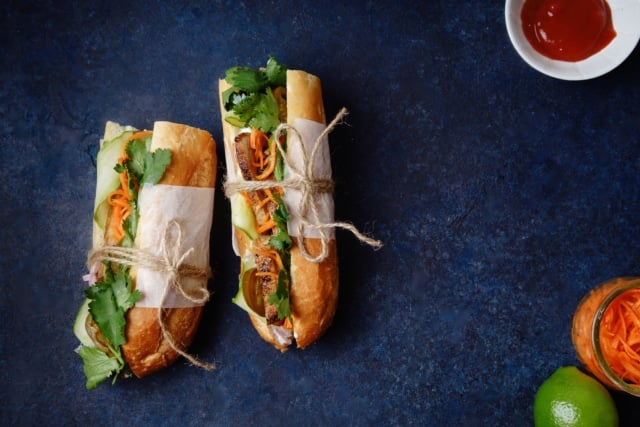
Bread, Pastries, Dessert
When you take a trip to Vietnam, one of the first things you’ll notice is that locals like their bread. That’s why there are hundreds of small bakeries scattered all over the country. Plus, the majority of Vietnamese restaurants will serve bread as a side dish to most meals.
This is likely due to French colonization. During the wartime occupation, baguettes became widely spread all over the Southeast Asian country. Yet, even after the colonization ended, the bread never disappeared from Vietnam.
Instead, the locals created their own version, banh mi. It’s a cross between a French-style baguette and a Middle Eastern loaf. The result is bread with a thin, crispy crust, and a soft, chewy center.
This made for the ideal loaf for sandwiches. You can split the loaves sideways and fill them with all sorts of ingredients like seafood or cured meats.
However, that’s not all Vietnam has to offer in terms of pastries. For instance, many street food vendors and Vietnamese restaurants serve banh pate so. This is a puff pastry filled with minced meat, onions, and a wide selection of herbs and spices.
Plus, when you’re after a sweet version of this dish, there’s an option filled with mung bean paste. That gives the pastry a buttery, sweet flavor, with a hint of saltiness.
If that triggers your inner sweet tooth, you’re in for a real treat. That’s because the Vietnamese cooking style has plenty of desserts to offer. One of the most popular choices in the Southeast Asian country is che ba mau or three-colored pudding.
This is an eye-catching dessert that consists of three layers, each with a distinct, vibrant shade. Some common ingredients for this dish include red kidney beans, yellow mung beans, and green pandan jelly.
Secret Recipe Tips
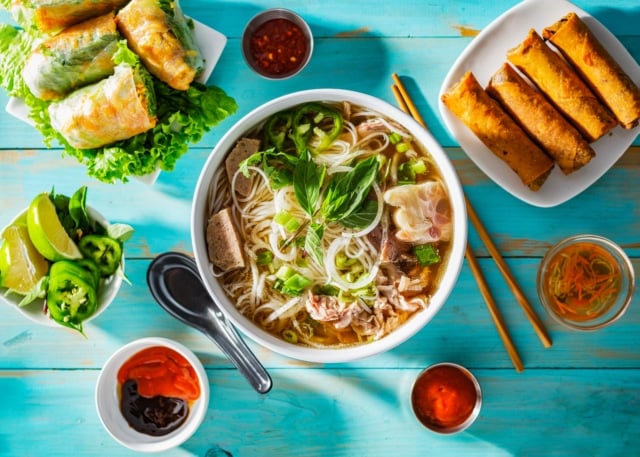
Secret Recipe Tips
With the basics of Vietnamese cuisine out of the way, we can move on to a few secret recipe tips. These tricks should help you master the Vietnamese cooking style in a flash. So, without further ado, let’s jump into the tips.
Get to Know Vietnamese Ingredients
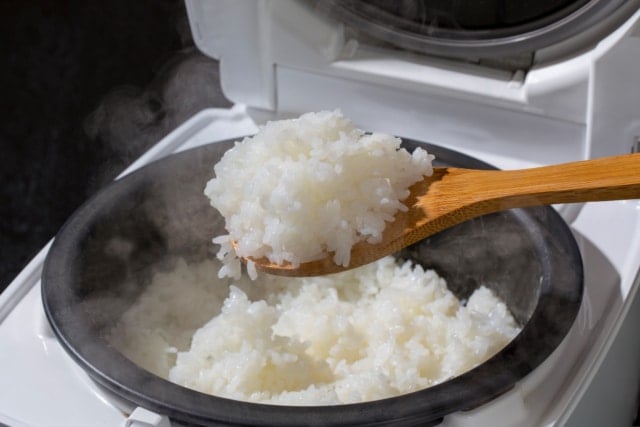
Get to Know Vietnamese Ingredients
Regardless of the type of cuisine you want to learn, the ingredients will always play a significant role in your final dish. So, to master the Vietnamese cooking style, there are a few common components you should familiarize yourself with.
First up, rice makes up a sizable portion of most Vietnamese dishes. Not only is it the main source of carbohydrates in the region, but locals also use rice flour to make all kinds of pastries.
Other than that, the Vietnamese cooking style relies heavily on components like fermented shrimp paste, cilantro, mint, green beans, and pickled vegetables.
Invest in a Good Quality Mortar and Pestle
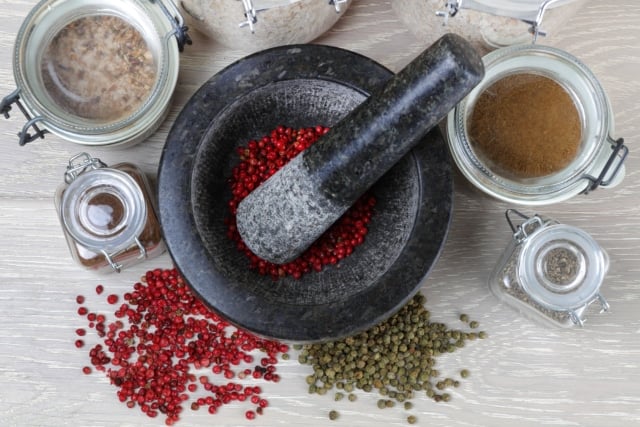
Invest in a Good Quality Mortar and Pestle
Throughout our journey into Vietnamese cuisine, you may have noticed that the Southeast Asian country likes to incorporate many pastes into its cooking style. From fermented shrimp paste to por kwan (beef-flavored paste) to tofu pates.
Unfortunately, these ingredients can be a little tough to source, depending on where you live. You may have to visit a specialty Vietnamese grocery store to get your hands on them.
However, you can also make these pastes at home to save yourself the trouble of running around ingredient hunting. In that case, you’ll need a good quality mortar and pestle to grind ingredients into a paste.
Balancing Flavors Is Key

Balancing Flavors Is Key
Vietnamese dishes often combine sweet elements with sour, spicy, or salty flavors. At first glance, this blend may seem strange. Yet, Vietnamese locals found a way to create harmonious taste profiles.
So, if you’re trying to recreate some of the most famous Vietnamese dishes, you need to master balancing flavors. This can be a little tricky to do, so experimentation is key.
Try out a few flavor combinations and figure out how much sweetness you can add to a meal before you alter the taste profile.
Experiment With Different Cooking Methods
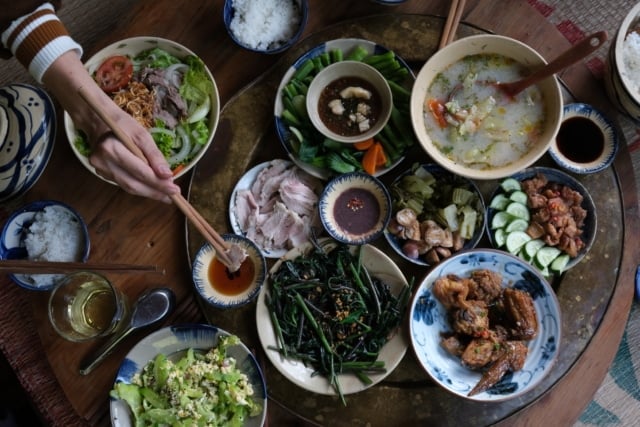
Experiment With Different Cooking Methods
To master Vietnamese cuisine, you may have to learn a couple of new cooking methods. That’s because the cooking style mainly relies on steaming and stir-frying.
Steaming allows you to cook ingredients without stripping them of their natural nutrients. Plus, it’ll allow the flavors of your dish to meld together, without overcooking your components. On top of that, many people consider steaming to be one of the healthiest cooking methods.
Moving on, stir-frying can preserve the freshness of the ingredients while infusing them with a smoky flavor.
Dipping Sauces Can Transform Your Dishes

Dipping Sauces Can Transform Your Dishes
From our exploration of Vietnamese cuisine, you may have noticed that many of the dishes have subtle flavor profiles. Well, the reason behind this is that locals love to indulge in dipping sauces. So, you can’t serve a traditional Vietnamese meal without preparing a few side dressings.
Here are some of the most well-liked dipping sauces in the area:
- Nuoc mam: This is a fish sauce with sweet, salty, savory, and spicy elements.
- Mam tom chua: This is a dipping sauce made of fermented or pickled shrimp.
- Mam nem: This is a fermented fish sauce with a pungent aroma and an intense flavor profile.
Presentation Matters
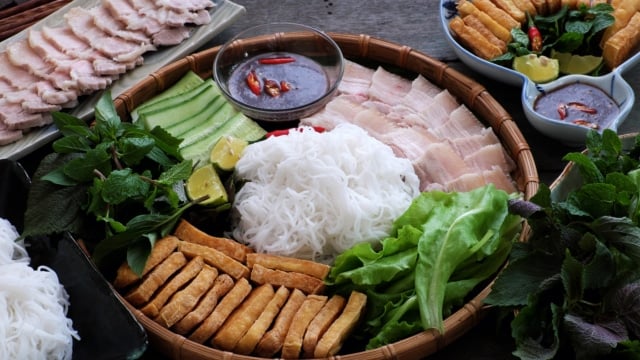
Presentation Matters
We’ve all heard the saying that people eat with their eyes before their mouths. That’s why the Vietnamese cooking style pays close attention to presentation. The local restaurants will ensure that their dishes look appetizing to make the dining experience unforgettable.
Even street vendors will garnish their sandwiches and finger foods for an extra flare. Yet, mastering Vietnamese presentation can be a little challenging.
So, it’s best to start small. For example, you can grab a few fresh mint or cilantro leaves and throw them on top of a savory dish to add a vibrant pop of green.
Practice Your Knife Skills

Practice Your Knife Skills
Vietnamese cooks will have to spend a lot of time chopping and mincing ingredients. They do that to ensure that components don’t take too long to steam or stir-fry. Because of that, most Vietnamese locals have advanced knife skills.
They can julienne, chiffonade, and brunoise with exceptional accuracy and at incredible speeds. So, if you’re trying to make an authentic Vietnamese dish, you’ll have to practice your knife skills.
Explore Regional Diversity

Explore Regional Diversity
Each region in Vietnam has its own distinct spin on traditional dishes. Some areas prefer their food a little spicier, while others enjoy subtle flavors. Because of that, there’s plenty of variety when it comes to Vietnamese cuisine.
So, before you start cooking, it’s good practice to explore the regional diversity. Learn about the different spices and herbs that each area relies on and find the one that best matches your taste buds.
Beverages

Beverages
The best way to round out any Vietnamese meal is with a traditional beverage. Luckily, the Southeast Asian country has plenty of drink options for you to choose from. For instance, there’s ca phe trung, which loosely translates to egg coffee.
As you can guess by the name, the main components of this beverage are egg yolks and coffee. This makes for a creamy drink that’s perfect for washing down a spicy Vietnamese meal.
Ingredients

Ingredients
The secret to any successful Vietnamese meal is using the right ingredients. So, to make your life easier, here are a few common ingredients that can elevate your Vietnamese cooking game:
- Star anise: This is a star-shaped seed pod that can add warmth and depth to your meal’s flavor profile.
- Rice paper: This is a thin pastry that locals use to wrap all sorts of ingredients.
- Water spinach: This leafy green is nutritious and adds a unique texture to any Vietnamese dish.
Herbs and Spices

Herbs and Spices
Herbs and spices are the cornerstones of Vietnamese cuisine. They round out flavor profiles and help ingredients blend together seamlessly.
- Cardamom: Has a spicy, earthy kick that’s ideal for broths.
- Turmeric: This golden powder has a nutty, almost earthy flavor profile that complements most fish dishes.
- Black pepper: This spice can add a little heat to any dish, without overpowering the other ingredients.
Vietnamese Food Culture

Vietnamese Food Culture
The food culture in Vietnam is as ancient as it is exciting. So, before your next trip to the region, you may want to familiarize yourself with some of the traditions of the Southeast Asian country.
Eating Habits

Eating Habits
Just like the US, Vietnam has three major meals throughout the day: breakfast, lunch, and dinner. Yet, it’s important to note that there are no fixed times for these meals.
Locals will typically sit down for food whenever they have a spare moment. So, depending on where you land in Vietnam, the meal schedule will be a little different.
Meal Structure

Meal Structure
Most Vietnamese dishes revolve around rice, vegetables, and fish. So, you’ll likely see all of these components in every meal. Besides that, Vietnamese locals love their snacks. They enjoy nibbling on sandwiches and other pastries throughout the day.
Etiquette

Etiquette
Vietnamese culture places a lot of importance on manners and respect. Because of that, it’s no surprise that the locals follow a few strict etiquette rules.
For example, it’s customary to leave a bit of food on your plate to signal that the host was generous and provided enough food. Other than that, it’s never a good idea to leave your chopsticks hanging off your plate.
- Tomato Juice. Health Benefits + Tips.
- Asparagus. Benefits for Your Health.
- Mango. Benefits and Side Effects.
- Peanuts. Health Benefits & Tips and Hacks.
- Polish Food. Popular Dishes and Recipe Tips.
- French Food. Secret Recipe Tips and Exciting Facts.
- Russian Food. Popular Dishes and Tips.
- Spearmint Tea. Health Benefits and Tips.
